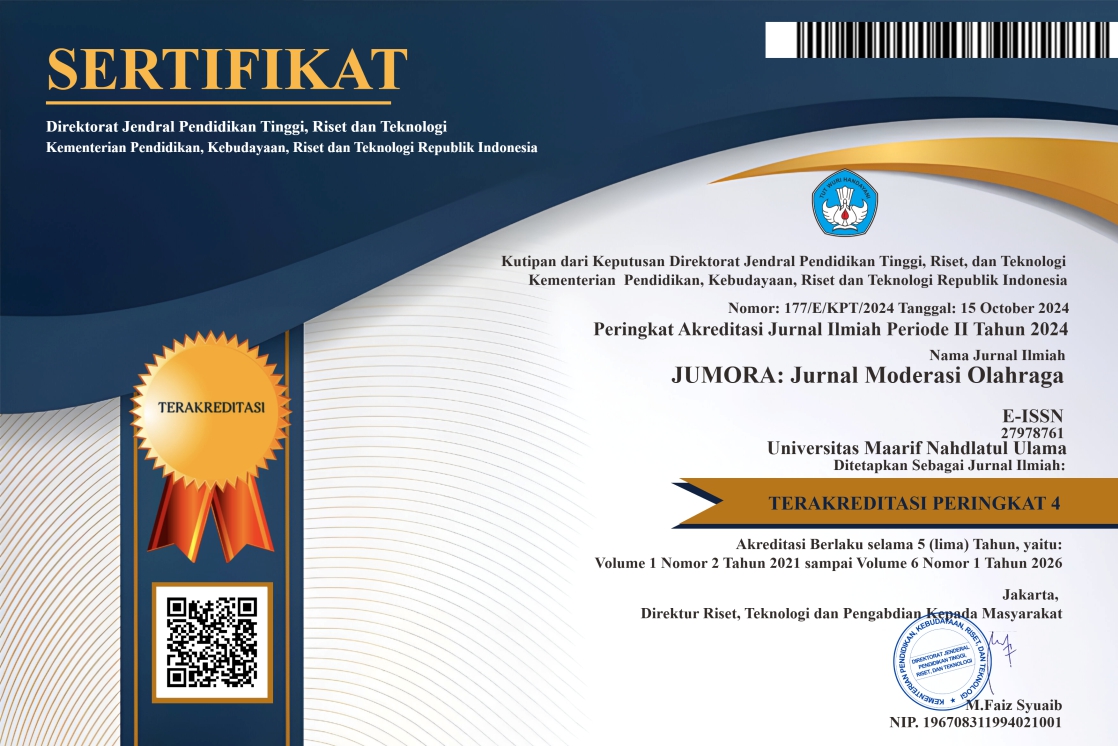Analysis of Life Skills of High School Students who Participate in Extracurricular Sports (Study Based on Regional Demographics)
DOI:
https://doi.org/10.53863/mor.v4i2.1435Keywords:
Extrtacurricular, Life Skills, Sports, StudentsAbstract
The purpose of this study was to analyze the level of life skills of high school students in rural areas who take part in extracurricular sports. The method used in this research is a quantitative descriptive method. The participants in this study were high school students in rural areas who participated in extracurricular activities. A total of 240 students were used as participants, consisting of 87 male students and 153 female students. The research instrument used was the Life Skills Assessment Scale (LSAS) developed by Pearson and Kennedy. The results showed that the level of life skills of high school students in rural areas was in a high level category, both those who participated in sports and non-sports extracurricular activities. Meanwhile, the Sig. (2-Tailed) on the Independent Samples Mann-Whitney U test analysis is 0.477. This finding indicates that there is no significant difference in the life skills of high school students who participate in extracurricular sports compared to those who participate in non-sport extracurricular activities (Sig. (2-Tailed) 0.005)
References
Adeyemo, S. A. (2010). The relationship between students ’ participation in school based extracurricular activities and their achievement in physics. 1(November), 111–117.
Bradley, J. L., & Conway, P. F. (2016). A dual step transfer model: Sport and non‐sport extracurricular activities and the enhancement of academic achievement. British Educational Research Journal, 42(4), 703–728.
Bronfenbrenner, U. (1979). The ecology of human development: Experiments by nature and design. Harvard University Press Google Schola, 2, 139–163.
Camiré, M., & Kendellen, K. (2016). Coaching for positive youth development in high school sport. In Positive youth development through sport (pp. 126–136). Routledge.
Camiré, M., Newman, T. J., Bean, C., & Strachan, L. (2022). Reimagining positive youth development and life skills in sport through a social justice lens. Journal of Applied Sport Psychology, 34(6), 1058–1076.
Catalano, R. F., Berglund, M. L., Ryan, J. A. M., Lonczak, H. S., & Hawkins, J. D. (2004). Positive youth development in the United States: Research findings on evaluations of positive youth development programs. The Annals of the American Academy of Political and Social Science, 591(1), 98–124.
Caterino, M. C., & Polak, E. D. (1999). Effects of two types of activity on the performance of second-, third-, and fourth-grade students on a test of concentration. Perceptual and Motor Skills, 89(1), 245–248.
Danish, S., Forneris, T., Hodge, K., & Heke, I. (2004). Enhancing youth development through sport. World Leisure Journal, 46(3), 38–49.
Deci, E. L., & Ryan, R. M. (2000). The" what" and" why" of goal pursuits: Human needs and the self-determination of behavior. Psychological Inquiry, 11(4), 227–268.
Gazda, G. M., & Brooks Jr, D. K. (1985). Social/life-skills training. Journal of Group Psychotherapy, Psychodrama and Sociometry, 38(1), 1–65.
Goldsmith, E. B. (1996). Resource management for individuals and families. West Publishing Company St Paul, MN.
Gould, D., & Carson, S. (2008). Life skills development through sport: Current status and future directions. International Review of Sport and Exercise Psychology, 1(1), 58–78.
Gould, D., Collins, K., Lauer, L., & Chung, Y. (2007). Coaching life skills through football: A study of award winning high school coaches. Journal of Applied Sport Psychology, 19(1), 16–37.
Holt, N. L., Neely, K. C., Slater, L. G., Camiré, M., Côté, J., Fraser-Thomas, J., MacDonald, D., Strachan, L., & Tamminen, K. A. (2017). A grounded theory of positive youth development through sport based on results from a qualitative meta-study. International Review of Sport and Exercise Psychology, 10(1), 1–49.
Johnston, J., Harwood, C., & Minniti, A. M. (2013). Positive youth development in swimming: Clarification and consensus of key psychosocial assets. Journal of Applied Sport Psychology, 25(4), 392–411.
Jones, M. I., & Lavallee, D. (2009). Exploring perceived life skills development and participation in sport. Qualitative Research in Sport and Exercise, 1(1), 36–50.
Kennedy, F., Pearson, D., Brett-Taylor, L., & Talreja, V. (2014). The Life Skills Assessment Scale: Measuring life skills of disadvantaged children in the developing world. Social Behavior and Personality, 42(2), 197–209. https://doi.org/10.2224/sbp.2014.42.2.197
Kohl III, H. W., & Cook, H. D. (2013). Educating the student body: Taking physical activity and physical education to school.
Lerner, R. M., Lerner, J. V, Almerigi, J. B., Theokas, C., Phelps, E., Gestsdottir, S., Naudeau, S., Jelicic, H., Alberts, A., & Ma, L. (2005). Positive youth development, participation in community youth development programs, and community contributions of fifth-grade adolescents: Findings from the first wave of the 4-H study of positive youth development. The Journal of Early Adolescence, 25(1), 17–71.
Ludden, A. B. (2011). Engagement in school and community civic activities among rural adolescents. Journal of Youth and Adolescence, 40, 1254–1270.
Moore, K. A. (2000). Children’s behavior and well-being: Findings from the National Survey of America’s Families.
Murdiyanto, E. (2020). Sosiologi perdesaan. Lembaga Penelitian dan Pengabdian Kepada Masyarakat (LP2M) UPN ”Veteran” Yogyakarta Press.
Nagaraju, M. T. V. (2016). Strategies to promote life-skills among adolescents. European Journal of Education Studies.
Nuri, F. P., Pitoewas, B., & Yanzi, H. (2016). Pengaruh Kegiatan Ekstrakurikuler Terhadap Perkembangan Life Skills Peserta Didik Sma Yp Unila. Lampung University.
Opstoel, K., Chapelle, L., Prins, F. J., De Meester, A., Haerens, L., van Tartwijk, J., & De Martelaer, K. (2020). Personal and social development in physical education and sports: A review study. European Physical Education Review, 26(4), 797–813.
Pierce, S., Gould, D., & Camiré, M. (2017). Definition and model of life skills transfer. International Review of Sport and Exercise Psychology, 10(1), 186–211. https://doi.org/10.1080/1750984X.2016.1199727
Ronkainen, N., Aggerholm, K., Allen-Collinson, J., & Ryba, T. V. (2023). Beyond life-skills: talented athletes, existential learning and (Un) learning the life of an athlete. Qualitative Research in Sport, Exercise and Health, 15(1), 35–49.
Rulyansah, A., & Sholihati, M. (2018). Pengembangan Modul Berbasis Kecakapan Hidup pada Pelajaran Matematika Sekolah Dasar. MUST: Journal of Mathematics Education, Science and Technology, 3(2), 194. https://doi.org/10.30651/must.v3i2.2088
Supriatna, M. (2006). Pengembangan Kecakapan Hidup di Sekolah. Pengembangan Kecakapan Hidup Di Sekolah, 11.
Turnnidge, J., Côté, J., & Hancock, D. J. (2014). Positive youth development from sport to life: Explicit or implicit transfer? Quest, 66(2), 203–217.
Whitley, M. A., Massey, W. V, & Leonetti, N. M. (2016). ‘Greatness (un) channelled’: the role of sport in the life of an elite athlete who overcame multiple developmental risk factors. Qualitative Research in Sport, Exercise and Health, 8(2), 194–212.
Wordl Health Organization. (1999). Partners in life skills education. World Health Organization, Department of Mental Health.
Yabunaka, Y., Kametani, R., & Tsuchiya, H. (2023). Generalization of Psychosocial Skills to Life Skills in Collegiate Athletes. Sports, 11(2), 20.
Downloads
Published
How to Cite
Issue
Section
License
Copyright (c) 2024 Muhammad Oktapian Nur Rajab, Agus Gumilar, Burhan Hambali

This work is licensed under a Creative Commons Attribution-ShareAlike 4.0 International License.
Authors retain copyright and grant the journal right of first publication with the work simultaneously licensed under a Creative Commons Attribution-ShareAlike 4.0 International License that allows others to share the work with an acknowledgment of the work’s authorship and initial publication in this journal











